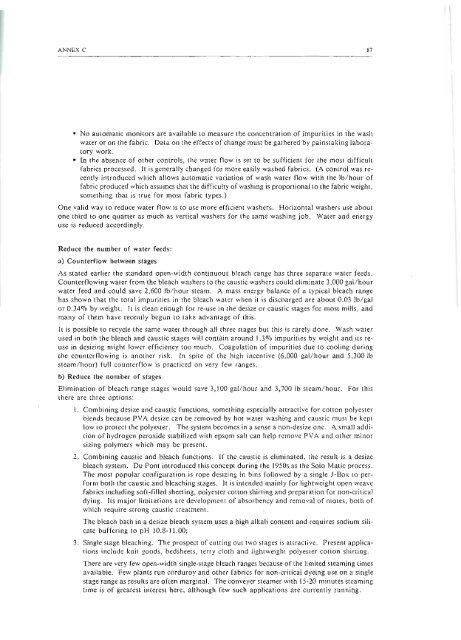Contributor, The Textile Industry and the Environment, UNEP
Contributor, The Textile Industry and the Environment, UNEP
Contributor, The Textile Industry and the Environment, UNEP
You also want an ePaper? Increase the reach of your titles
YUMPU automatically turns print PDFs into web optimized ePapers that Google loves.
ANNEX C<br />
• No aU1OQ1atic monitors are available to measure <strong>the</strong> concentration of impurities in <strong>the</strong> wash<br />
water or on <strong>the</strong> fabric. Data on <strong>the</strong> effects of change must be ga<strong>the</strong>red by painstaking laboratory<br />
work.<br />
• In <strong>the</strong> absence of o<strong>the</strong>r controls, <strong>the</strong> water flow is set to be sufficient for <strong>the</strong> most difficult<br />
fabrics processed. It is generally changed for more easily washed fabrics. iA control was recently<br />
introduced which allows automatic variation of wash water flow with <strong>the</strong> lb/hour of<br />
fabric produced which assumes that <strong>the</strong> difficulty of washing is proponionaJ to <strong>the</strong> fabric weight,<br />
something that is true for most fabric types.)<br />
One valid way to reduce water flow is 10 use more efficient washers. Horizontal washers use about<br />
one third 10 one quarter as much as vertical washers for <strong>the</strong> same washing job. Water <strong>and</strong> energy<br />
use is reduced accordingly.<br />
Reduce tbe number of water feeds:<br />
a) Counterflow between stages<br />
As stated earlier <strong>the</strong> st<strong>and</strong>ard open-width continuous bleach range has three separate water feeds.<br />
Counterflowing water from <strong>the</strong> bleach washers to <strong>the</strong> caustic washers could eliminate 3,000 gal/hour<br />
water feed <strong>and</strong> could save 2,600 Ib/hour steam. A mass energy balance of a typical bleach range<br />
has shown that <strong>the</strong> total impurities in <strong>the</strong> bleach water when it is discharged are about 0.03 lb/gaJ<br />
or 0.340/0 by weight. It is clean enough for re-use in <strong>the</strong> desize or caustic stages for most mills, <strong>and</strong><br />
many of <strong>the</strong>m have recently begun to take advantage of this.<br />
It is possible to recycle <strong>the</strong> same water through all ,hree stages but this is rarely done. Wash waler<br />
used in both <strong>the</strong> bleach <strong>and</strong> caustic stages will contain around 1.3070 impurities by weight <strong>and</strong> its reuse<br />
in desizing might lower efficiency tOo much. Coagulation of impurities due to cooling during<br />
<strong>the</strong> counterflowing is ano<strong>the</strong>r risk. In spite of <strong>the</strong> high incentive (6,000 gal/hour <strong>and</strong> 5,300 Ib<br />
steam/hour) full counterflow is practiced on very few ranges.<br />
b) Reduce <strong>the</strong> number of stages<br />
Elimination of bleach range stages would save 3,100 gal/hour <strong>and</strong> 3,700 lb steam/hour. For this<br />
lhere are three options:<br />
I. Combining desize <strong>and</strong> caustic functions, something especially attractive for COlton polyester<br />
blends because pYA desize can be removed by hot water washing <strong>and</strong> causlic muSI be kept<br />
low to prOtecl <strong>the</strong> polyester. <strong>The</strong> system becomes in a sense a non-desize one. A small addition<br />
of hydrogen peroxide stabilized with epsom salt can help remove PVA <strong>and</strong> o<strong>the</strong>r minor<br />
sizing polymers which may be presenl.<br />
2. Combining caustic <strong>and</strong> bleach functions. If <strong>the</strong> caustic is eliminated, <strong>the</strong> result is a desize<br />
bleach system. Du Pont introduced this concept during <strong>the</strong> 1950s as <strong>the</strong> Solo Matic process.<br />
<strong>The</strong> most popular configuration is rope desizing in bins followed by a single J-80x to perform<br />
bot]l <strong>the</strong> caustic <strong>and</strong> bleaching stages. II is intended mainly for lightweight open weave<br />
fabrics including soft-filled sheeting, polyester collon shirting <strong>and</strong> preparation for non-critical<br />
dying. Its major limitations are development of absorbency <strong>and</strong> removal of motes, both of<br />
which require strong caustic treatmen!.<br />
<strong>The</strong> bleach bath in a desize bleach system uses a high alkali content <strong>and</strong> requi res sodium silicate<br />
buffering to pH 10.8-11.00;<br />
3. Single stage bleaching. <strong>The</strong> prospect of cutting out two stages is attractive. Present applications<br />
include knit goods. bedsheets, terry cloth <strong>and</strong> lightweight polyester cotlon shirting.<br />
<strong>The</strong>re are very few open-width single-stage bleach ranges because of <strong>the</strong> limited steaming times<br />
available. Few plants run corduroy <strong>and</strong> o<strong>the</strong>r fabrics for non-critical dyeing use on a single<br />
stage range as results are often marginal. <strong>The</strong> conveyer steamer with 15-20 minutes steaming<br />
ti me is of g,eatest interest here, although few such applications are currently running.<br />
87

















